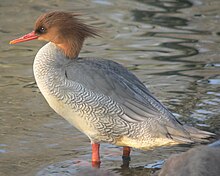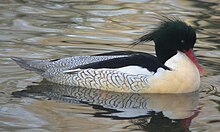Scale saw
| Scale saw | ||||||||||||
|---|---|---|---|---|---|---|---|---|---|---|---|---|

Scale saw, male |
||||||||||||
| Systematics | ||||||||||||
|
||||||||||||
| Scientific name | ||||||||||||
| Mergus squamatus | ||||||||||||
| Gould , 1864 |
The scale saw ( Mergus squamatus ) is a species from the duck family and belongs to the genus of the saws . Its distribution area is in East Asia. Its numbers are declining. The worldwide population is currently estimated at 1,200 breeding pairs. This has not yet fallen below a critical population like that of the South American dark saw. Due to the declining population, it cannot be ruled out that this species will become extinct similar to the Aucklandsäger .
Appearance
In terms of body size, the scales saw lies between the goose saw and the middle saw . The males weigh an average of 1200 grams, the females a little less than a kilogram. The red beak is straighter and longer than the middle saw and has a lighter, yellowish-white nail at the end. It lacks the downward curved beak end, as is characteristic of the goosander. The scales saw the nostrils are in the middle of the beak, while they are in the basal part of the beak in the middle saw and goosander. In flight it shows a similar appearance as the common saw, but since its range only overlaps with that of the goose saw, an identification of this species is not very difficult.
The species shows a pronounced sexual dimorphism . In their splendid dress, the males have black plumage on the head and neck. Depending on the light, the head plumage shimmers green. The black feather hood is striking. The chest and underside are white. The feathers of the flanks and the back plumage have a wide black end border, so that the plumage here is strikingly black and white. The under tail cover is white with fine gray dots. The tail feathers are silver gray. When resting, the male resembles the female. The typical flank scaling is missing or only hinted at. The head of feathers is greatly shortened.
The female is gray on the dorsal plumage and the upper side of the wings. The throat and chest are white. The head and neck are brown to red-brown with a long, thin head of feathers. The flanks are scaled white and dark gray. The tail feathers are silver-gray as in the male. The young birds are similar to the female, but have a darker head and less and paler scaling on the flanks. From a distance, the flanks often appear dirty gray.
The chicks have the downy dress that is characteristic of Säger. The parting and the upper part of the cheeks are reddish brown. The cheeks become lighter towards the bottom. A white spot under the eye and a white crescent moon under the eye make the face appear striped overall. The top of the body is ash gray with a slight brownish tinge. There are white spots on the shoulders, as well as on the sides of the trunk. The underside of the body is white.
distribution
The scale saw occurs predominantly in the far east of Russia. A small part breed in northern China. There may also be breeding pairs in North Korea.
The Russian population breeds predominantly south of 54 ° N on the rivers on the west side of the Sichote-Alin Mountains, to a lesser extent also on the east side and in the catchment area of the Amur between the tributaries Seja and Amgun . The main distribution area are the rivers Bikin and Great Ussurka (Bolshaya Ussurka, formerly Iman), where 200 and 140 pairs respectively breed.
In China, scale saws are mainly found in Jilin Province , where they breed mainly on the northeastern side of the Changbai Mountains . Scale saws are also found in Heilongjiang Province . They settle in small numbers in the Small and the Great Hinggan Mountains .
Moulting scaled saws can be found on the Russian and Chinese coasts as well as on some rivers and large lakes. They can then also be observed in North Korea. The winter quarters are not exactly known. The withdrawal to the winter quarters starts in October when the river freezes. The winter quarters are presumably in southern China as well as in central China. They also overwinter in small numbers in the southwest of South Korea, in Japan and on Taiwan. Odd visitors can occasionally be found in Tibet , Thailand , Vietnam and Myanmar .
habitat
Scale saws mainly populate the upper and middle reaches of rivers in regions wooded with deciduous and mixed forest. The distribution area is characterized by cold, dry winters and warm and rainy summers. The rivers are usually frozen over from October to March. Scales saws prefer clear, fast-flowing rivers with gravel banks and banks. The river banks are densely overgrown and, in addition to old trees, have a dense, low layer of vegetation.
Diet and nutrition
Scale saws mainly eat small fish and invertebrates. The technique with which they look for their food depends on the depth of the water. In shallow water, they only submerge their heads while diving in deeper waters. In the breeding areas, feeding takes place predominantly in zones of less than one meter deep water. For scaled saws, which could be observed in China, the dives lasted between 15 and 30 seconds. There was an interval of 3 to five seconds between the individual dives. The scales saws spent between 14 and 15 hours a day searching for food.
Reproduction
The Russian populations return to their breeding grounds between late March and early April. At this point the rivers begin to thaw. The pairing takes place at the time of return. During the first week of the breeding season, the male is still near the nest and the female. Then the pair bond loosens and the male moves into the moulting areas.
The pangolin courtship repertoire includes nodding the head, throwing the head, stretching the neck, striking wings, and diving. The courtship gestures are shown by both sexes and are often performed synchronously. Scales saws also show aggressive gestures during courtship, in which the male in particular attacks the female underwater or chops at the female. During copulation, the male bites its beak into the feathers of the female's crested hood.
Nests are built exclusively in tree hollows. They use natural tree hollows as well as those hollowed out by other bird species. Typical nesting trees are poplar, elm and oak. The nests are usually in trees that are directly on the river bank. Occasionally, however, they can be up to 120 meters from the river bank. The distance between the cave and the ground is often very large. The caves usually have an opening of 15 to 25 centimeters and are 20 to 60 centimeters deep. The actual nesting trough is 20 to 30 centimeters wide. The nest is laid out with fine gray down. Mandarin ducks are assumed to be nesting site competitors . It is very certain, however, that the scales saw competes with the goosander for suitable nesting sites. Goosanders have expanded their distribution in eastern Russia and are now also settling on the bikini area.
Egg laying begins in the first week of April and is completed in the last week of April. The eggs are creamy white and indistinguishable from those of other sawmill species. The full clutch usually consists of 10 to 11 eggs. Very large clutches can hold 14 eggs. Scale saws only raise one brood per year. However, the female lays a replacement clutch if the brood is lost at the beginning of the breeding season. The laying interval is 36 hours, so that the clutch is complete after 15 to 16 days. The incubation period is 32 days.
The newly hatched chicks remain in the brood cavity for 48 to 60 hours. They then leave them jumping, the female calling them to do so. The young birds can fledge at eight weeks.
Causes of the decline in stocks
Several factors are contributing to the decline in the scale saw population. One factor is that the North American mink was introduced into the range and hunts down the scaled saws. The main causes of the population decline are the increasing destruction of suitable habitats. The number of breeding pairs on the bikin fell by more than half after the logging increased in this region. Hunting also leads to disturbances, even if it is aimed at other species. However, the scales saw is also illegally hunted in parts of its range. More than 100 scales saws fell victim to illegal hunting on bikini. It is particularly serious that this hunt mainly takes place in spring and that the birds that are shot are mostly adult. The mining of raw materials such as gold and ores, which cause severe water pollution, has already resulted in some smaller rivers in the fact that scale saws no longer breed there. The (planned) construction of hydropower plants will also have a negative effect on the stock figures, as it will permanently change the water turbidity and the flow rate of the populated waters.
Another cause of mortality is drowning in fishing nets. On the eastern rivers of the Sichote-Alin , 20 percent of the young birds per year die in this way.
Keeping in human care
Scale saws are extremely rarely kept in zoos. Until the late 1980s, only Chinese zoos kept some scaled saws. In 1998 some Belgian and Dutch breeders owned a few pairs. Currently also keep Tierpark Berlin , the Augsburg Zoo and Tierpark Cottbus each have a pair. Today, the number of scaly saws in captivity is steadily increasing (especially in private breeding facilities), so that in the future it is to be expected that the number of exhibits will exceed the number in the wild.
supporting documents
Individual evidence
- ↑ a b c d Kear, p. 760
- ^ Kear, p. 759
- ↑ a b c Kolbe, p. 320
- ↑ a b Kolbe, p. 321
- ↑ a b c Kear, p. 761
- ^ Kear, p. 762
- ↑ a b c Kear, p. 763
- ↑ Ulrike Elsner: Much growth in the birds. In: Lausitzer Rundschau. December 28, 2017. Retrieved December 29, 2017 .
literature
- Janet Kear (Ed.): Ducks, Geese and Swans. Oxford University Press, 2005, ISBN 0-19-854645-9 .
- Hartmut Kolbe; Die Entenvögel der Welt , Ulmer Verlag 1999, ISBN 3-8001-7442-1
Web links
- Mergus squamatus inthe IUCN 2013 Red List of Threatened Species . Listed by: BirdLife International, 2012. Retrieved October 10, 2013.


